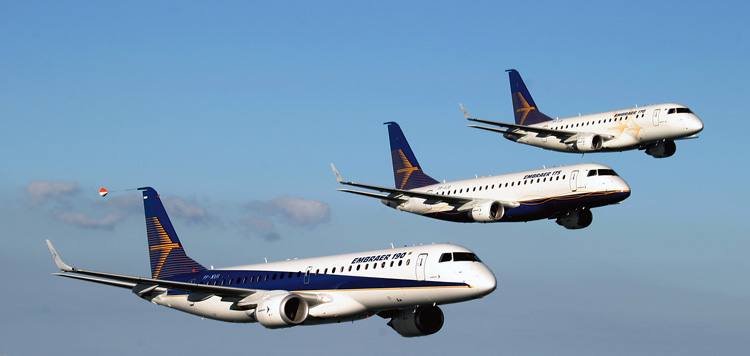- Prime Minister Narendra Modi inaugurates Aero India 2023 in Bengaluru; Releases Commemorative Stamp
- Defence Secretary meets delegations from Saudi Arabia, USA and Oman on the sidelines of Aero India 2023
- Foreign Ministers of 32 countries to attend Aero India 2023
- Embraer showcases the C-390 Millennium at Aero India 2023
‘I am confident that we will see E-Jets flying within India before very long’
Interview with Paolo César de Souza e Silva President, Commerc ial Aviation, Embraer

SP’s ShowNews (SP’s): Indian commercial aviation continues to experience upheaval and a number of “fixes” have recently been proposed or approved to stabilise the situation including the easing of foreign ownership rules, allowance for importing fuel and perhaps even subsidising regional air service to encourage route dispersal. What do you make of such developments?
Paolo Cesar de Souza e Silva (Silva): Some of the important new products introduced by BEL in the past one year are – Bharani, a low level lightweight radar; Hullmounted sonar (detecting subsurface targets in sea); New electronic voting machine (EVM); Voter verifiable paper audit trail, a printing attachment to the EVM; and radio for LIC EW system, a direction finding subsystem of low intensity conflict electronic warfare.
SP’s: Share your thoughts on network-centric warfare (NCW) systems developed indigenously for the Indian defence forces.
Silva: The process of airline industry liberalisation has always been Darwinian. In more developed markets such as North America and Europe, stability has taken several decades to achieve. Industry consolidation occurs over the course of several business cycles, not just one or two. We have seen this most recently in other emerging markets such as Brazil and Mexico-both of which offer strong demographic and geographic similarities to the Indian market-and where the marketplace is rewarding innovation, and as a result, more people are flying for the very first time than ever before.
SP’s: What can India learn from experiences in Brazil and Mexico?
Silva: Passengers want safe, reliable air transport that connects them to all the places they want to go, not just between metro markets. New nonstop flights from Tier-II and Tier-III cities consistently show the highest rates of traffic growth because they have traditionally been so poorly served. E-Jets are at the forefront of this development in both countries-at Aeromexico and Azul and TRIP (in Brazil) respectively; each has stimulated local passenger demand beyond anybody’s expectations.
SP’s: Azul and TRIP are both LCCs, and today, LCCs account for 70 plus per cent of the Indian domestic market. How do you see this changing, if at all?
Silva: LCCs are hard-wired for growth, trying to achieve economies of scale very quickly and almost always focusing on cost per seat rather than cost per trip. The problem is that they often have to buy market share because their aircraft are too large for all but the most heavily travelled routes. This is why we have seen so many LCCs change their business models as they mature. JetBlue in the US, Virgin Australia, and Niki in Europe now all use E-Jets to right-size schedules on many of their core routes. This is what I expect to also happen in the Indian market.

SP’s: But domestic traffic is forecast to grow at 12 per cent annually. Won’t larger capacity aircraft be needed sooner rather than later?
Silva: This is a fallacy. In India, the demand for air service is growing much faster in Tier-II and Tier-III cities and we do not anticipate this trend changing anytime soon. There are dozens of routes which today could justify first-ever nonstop flights with a 100-seat jet but where demand is not sufficient for a narrow body such as Ahmedabad-Nagpur or Hyderabad-Trivandrum. In fact, small jets are a much more efficient way to develop new markets like these. We agree completely that the demand for air service is growing faster in India than in all but a few of the world’s markets. Despite this outlook, our analysis shows that the number of routes being served nonstop has remained virtually unchanged since 2007, and so there is a disconnect somewhere.
SP’s: Can you elaborate?
Silva: Basically, the supply and demand metrics are misaligned. The Indian airline fleet is already very highly concentrated on 120 plus seat narrow bodies-which will only grow more extreme if all outstanding B737 and A320 orders are actually delivered. This one segment could account for more than 80 per cent of all capacity by 2020. What this tells me is that India today lacks a robust regional aviation sector to cater to the dozens-perhaps hundreds of smaller cities which will demand more nonstop carrier and destination choices in the years ahead. And by regional aviation, I mean aircraft with fewer than 120 seats can serve routes from 400 to 2,000 miles comfortably.
SP’s: Why are there not more dedicated regional airlines in India?
Silva: There are a variety of reasons, of course. The government’s historical two-airline policy and the subsequent first wave of consolidation come immediately to mind. But the market ultimately hates a vacuum and there is no shortage of either entrepreneurs or airline business plans in India today. I am confident that we will see E-Jets flying within India before very long.





